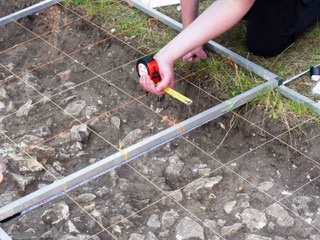Summer 2021 Dig Diary - We're Digging Again!
- Av
- Jul 30, 2021
- 6 min read
Updated: Aug 15, 2021
August update: Our Summer Dig is now complete - read on to see what we uncovered.
DAY 1: After a year of solitary activities we are back together outdoors. We have been invited to take part in the Bishop Grosseteste University dig supporting the students. The first job was to was to remove the topsoil. All finds are put to one side and recorded. It was a good day, the sun was shining, we could chat with everyone and we had finds including some very interesting pottery from a variety of time periods.
DAY 2: Another gloriously sunny day. Still cleaning off the topsoil. The ground is rock hard so we are using pick axes to break it up but we need to watch out for artefacts. The finds specialist prefers whole clay pipe bowls!
We uncover a layer of stones. Are they part of a surface? Initially, this involves working outwards to find the extent of the surface. After much pick axing and trowelling we discover there are three distinct areas as the stones lie in different ways. This is all really encouraging and a great start to the dig.
Day 3: Some great finds coming up including a slate pencil. In the Victorian era slates were used in all schools. The slates were made from slices of a metamorphic rock, slate. The hard slate material was generally set in a wooden frame, and writing was done with the aid of a slate pencil, also a piece of slate or shale which was sharpened to a point. The slate pencil made a mark of grayish silver on the slate, but could easily be erased with a cloth or a sleeves. The slate was used because paper was expensive. Work done on a slate could not be retained an learning had to be memorised. The slate pencil could break if dropped.
Our surface is really dry so we were able to brush it clean to prepare it for recording -measuring, planning and the all-important site photographs. If we deside to excavate below this surface, these record will be all that remainso it's important to extract all the information possible before moving on with the dig.
Day 7: We Can't Control the Weather! Due to rain we were unable to dig. It is not that we are soft, but we have to consider health and safety and also the possible damage to the site from trowelling in muddy conditions. Not to worry though as there is plenty of work to do on finds from previous digs. Normally we would have worked on these finds during our weekly meetings during winter but due to Covid 19 we were unable to do so there is a backlog to be tackled.
One are for attention is sorting the animal bones and teeth. The bone is going to a specialist to identify but first we need to establish the quantity of bone we need to send. The bone may provide information about the diet of the people, whether the animals were healthy and where the animals were raised.
Whilst ceramic and bone can be washed metal and glass items need careful cleaning by other processes such as dry brushing. There's plenty to keep us busy!
Day 10: Today we've been thinking about the importance of context labelling. In a dig, context is the place where an artefact is uncovered. Not just the place but the type of soil, site type and what the artefact was found with. If you went into a stranger's home and looked at the contents you might be able to work out their gender, age, interests and other unique aspects about that person. However, if you were just given the contents one by one and looked at them separately you might arrive at different conclusions.
Every item we find is placed in trays labelled with the context number. This number corresponds to a three-dimensional map of the entire site where every trench and level within that trench has a unique number. As an example this label would indicate that the find was made at the Welton dig in 2020 in context 901.
Back out at the trench, we've found a layer of clay at one end of the dig, so we'll continue to remove soil to establish the extent of that clay layer.
Day 12: We're finding a variety of shells - oyster, whelk and land snails. Molluscs have been a popular source of food at various times throughout history and we know oysters have been eaten in Britain since at least Roman times. To avoid food poisoning, oysters need to be eaten as fresh as possible and these probably arrived in Lincoln via the River Withan in barrels of sea water. There is also evidence that they were cultivated in beds on the south and east coasts of Britain during Roman times to meet demand.
Once the mollusc meat was consumed, the shells were also used and are an integral part of some types of pottery production known as 'shell-tempered ware'. The ground up shell is visible as white flecks (inclusions) in the clay. Temper helps a pot survive the firing process, resist cracking, and helps prevent breakage throughout the life of the pot.
Day 14: After a few days of heavy rain we're back in the trench and it's great to be digging again. One job we've been catching up on is sorting the pottery sherds that have already been recovered. It can be difficult to visualise the original vessel from just a small piece, but thankfully, if we find a section of the pot lip then a 'rim chart' gives us some idea.
We place a piece of pottery on the curved lines until the edge matches it exactly. Then we work out the diameter by following the correct line to the edge of the chart and read off the number.
Day15: Every bucketfull of soil that comes out of the trench is seived to check for small items. These can be pieces of pottery or even metalwork like pins or nails. Very occassionally, items like jewellery, glass beads or coins are missed in the trench to the delight of whoever is seiving. Wildlife, like this summer chafer beetle, can also make a sudden appearance. If this happens, a sit down beside one of nature's gentler representatives on the site is recommended!
Day 21: As the excavation expands, volunteers and students are working on their own particular sections of the trench. This gives continuity to the record keeping and is extremely statisfying for the digger. It's also a useful training experience to follow a timeline back through history and understand the decisions made by the site archaeologist and the potential interpretations considered as the past emerges, layer by layer.
The site is revealling itself as a place of both work and play in the Roman period. Recent finds include this awl, shaped from a pice of bone, and this gaming counter which has been made from a piece of broken pottery. Recycling at its best!
Day 22: We've been making great progress but just as we think we've hit the natural soil base layer some more Roman pottery pops up, in this case the bottom of a cooking pot which has become wedged beneath a boulder. In contrast to the dark clay heavy cooking pot we're also finding pieces of fine hard gloss Samien ware. This high quality table ware was made in Gaul from deposits of illite clay. The smooth red surface was created by dipping the unfired pot into a slip (liquified clay) before it went into the kiln.
Day 23: And there's more! It is not always possible or necessary to excavate the whole trench to the same depth. Specific areas which may give more insight into the archaeology are dug. In the side walls of these smaller excavation, the various layers and their colours can be seen. The size of the person digging doesn't necessarily match the size of the hole and it can be a tight squeeze, but finds like this Roman flagon neck make it worthwhile. Some archaeology, like this medieval hearth, take days to meticulously record before it can be removed for further research.
Day 24: Thoughout the dig, measuring tapes are used to accurately locate and record the extent and components of the layers in the side (section) of the trench. The depths of the contexts and the precise spots where small finds have been uncovered are measured. This can be done using a dumpy and staff. The dumpy is like a horizontal telescope and the staff is like a vertical ruler (see illustration below). A reading is taken at 'A' and then at 'B'. In this case the reading at 'B' is greater than that at 'A' so the height of 'C' is is below that of the site datum point.
During the post-excavation process, all collected data is used to reconstruct the site either on paper or digitally.
Our Summer Dig is now complete - We've uncovered some interesting archaeology and, like all excavations, the descoveries will continue as the finds are processed and the site gives up a few more of its secrets.



































































Great news you're back on site! Fingers crossed for suitable digging weather. Be interesting to see what you find.